Review on Local Buckling of Hollow Box FRP Profiles in Civil Structural Applications
Abstract
1. Introduction
1.1. Background
1.2. Research Significance
2. Local Buckling in Composites
3. Geometric Parameters of Hollow Box PFRP Profiles
3.1. Wall Slenderness
3.2. Cross-Sectional Aspect Ratio
3.3. Corner Geometry
4. Layup Parameters of Hollow Box PFRP Profiles
4.1. Axial-to-Inclined Fibre Ratio
4.2. Inclined Fibre Angle
4.3. Stacking Sequence
5. Conclusions
- Hollow box PFRP profiles are featured with higher structural stability and torsional rigidity compared to the open-section profiles due to the restraint at both ends of the wall and its unique stresses distribution. However, their design parameters have not been studied comprehensively as for open-section and laminated plate geometries. While local buckling is inevitable for open-section profiles, it can be avoided for box profiles if the wall slenderness is optimised due to the high buckling-to-material strength ratio and the available optimisation range. This will allow the design to consider the ultimate material strength rather than considering the lower buckling strength.
- The flange-web junction (corner) radius and its effect on the local buckling of hollow box PFRP profiles have not been studied or quantified even though its effect was significant on the buckling behaviour and failure mode of open-section profiles. Moreover, the interaction between the layup properties or the flange-web slenderness and the corner geometry has not been studied for box profile geometry. In addition, the effect of continuous confinement provided by the wound fibres around the corners in pulwound box profiles has not been reported. The corner (fillet) radius is not included in the analysis and design equations of box PFRP profiles. No study was found to address the inner and outer corner radii effect on the local buckling capacity as manufacturing parameters of PFRP profiles.
- Pulwound box FRP profiles were recently introduced for infrastructure applications with better transverse and circumferential properties. However, studies are still needed to comprehensively address all the critical design parameters controlling the local buckling of these profiles and quantify their relative contributions and interactions. Considering these interactions can facilitate economic structural designs and guidelines for these profiles, eliminate any conservative assumptions, and update the current design standards and manuals. Understanding the contributions and interactions of these parameters will broaden the use of these profiles with competitive structural performance and cost versus the conventional construction materials.
- As with the other structural shapes, there is a need to construct design curves and failure maps for hollow box PFRP profiles, considering the interactions and showing the shift in the failure modes in terms of the critical design parameters. Investigating these review findings, especially the importance of the interactions, will enhance the current design guidelines, facilitate economic and competitive designs, and manufacture optimised profiles for civil structural applications.
Author Contributions
Funding
Institutional Review Board Statement
Informed Consent Statement
Data Availability Statement
Acknowledgments
Conflicts of Interest
References
- Boisse, P. Advances in Composites Manufacturing and Process Design; Woodhead Publishing: Sawston, UK, 2015. [Google Scholar]
- Hoa, S.V. Principles of the Manufacturing of Composite Materials; DEStech Publications, Inc.: Lancaster, PA, USA, 2009. [Google Scholar]
- Ahn, N.; Lee, J.; Lee, K.; Jang, H.S. An experimental study on flexural behavior for a FRP composite girder. Constr. Build. Mater. 2014, 50, 13–21. [Google Scholar] [CrossRef]
- Johnston, J.; Mirza, O.; Kemp, M.; Gates, T. Flexural behaviour of alternate transom using composite fibre pultruded sections. Eng. Fail. Anal. 2018, 94, 47–68. [Google Scholar] [CrossRef]
- Muttashar, M.; Karunasena, W.; Manalo, A.; Lokuge, W. Behavior of pultruded multi-celled GFRP hollow beams with low-strength concrete infill. In Mechanics of Structures and Materials XXIV: Proceedings of the 24th Australian Conference on the Mechanics of Structures and Materials, ACMSM24, Perth, Australia, 6–9 December 2016; CRC Press: Boca Raton, FL, USA, 2019; p. 243. [Google Scholar]
- Friberg, E.; Olsson, J. Application of Fibre Reinforced Polymer Materials in Road Bridges—General Requirements and Design Considerations. Master’s Thesis, Chalmers University of Technology, Gothenburg, Sweden, 2014. [Google Scholar]
- Li, Y.-F.; Hsu, T.-H.; Hsieh, F.-C. A Study on Improving the Mechanical Behaviors of the Pultruded GFRP Composite Material Members. Sustainability 2019, 11, 577. [Google Scholar] [CrossRef]
- Satasivam, S.; Bai, Y. Mechanical performance of bolted modular GFRP composite sandwich structures using standard and blind bolts. Compos. Struct. 2014, 117, 59–70. [Google Scholar] [CrossRef]
- Xin, H.; Mosallam, A.; Liu, Y.; Xiao, Y.; He, J.; Wang, C.; Jiang, Z. Experimental and numerical investigation on in-plane compression and shear performance of a pultruded GFRP composite bridge deck. Compos. Struct. 2017, 180, 914–932. [Google Scholar] [CrossRef]
- Hizam, R.M.; Manalo, A.C.; Karunasena, W.; Bai, Y. Behaviour of pultruded GFRP truss system connected using through-bolt with mechanical insert. Compos. Part B Eng. 2019, 168, 44–57. [Google Scholar] [CrossRef]
- Kumar, P.; Chandrashekhara, K.; Nanni, A. Testing and evaluation of components for a composite bridge deck. J. Reinf. Plast. Compos. 2003, 22, 441–461. [Google Scholar] [CrossRef]
- Mottram, J.T.; Henderson, J. Fibre-Reinforced Polymer Bridges—Guidance for Designers; CIRIA: London, UK, 2018. [Google Scholar]
- Cricrì, G.; Perrella, M. Investigation of mode III fracture behaviour in bonded pultruded GFRP composite joints. Compos. Part B Eng. 2017, 112, 176–184. [Google Scholar] [CrossRef]
- Garrido, M.; Madeira, J.F.A.; Proença, M.; Correia, J.R. Multi-objective optimization of pultruded composite sandwich panels for building floor rehabilitation. Constr. Build. Mater. 2019, 198, 465–478. [Google Scholar] [CrossRef]
- Vedernikov, A.; Safonov, A.; Tucci, F.; Carlone, P.; Akhatov, I. Pultruded materials and structures: A review. J. Compos. Mater. 2020, 54, 4081–4117. [Google Scholar] [CrossRef]
- Fangueiro, R. Fibrous and Composite Materials for Civil Engineering Applications; Elsevier: Amsterdam, The Netherlands, 2011. [Google Scholar]
- Godat, A.; Légeron, F.; Gagné, V.; Marmion, B. Use of FRP pultruded members for electricity transmission towers. Compos. Struct. 2013, 105, 408–421. [Google Scholar] [CrossRef]
- Balasubramanian, M. Composite Materials and Processing; CRC Press: Boca Raton, FL, USA, 2013. [Google Scholar]
- Gajjar, D. Development of applications and innovation of FRP Pultruded Profiles in India & Asia. In Proceedings of the Fifteenth World Pultrusion Conference, Antwerp, Belgium, 27–28 February 2020. [Google Scholar]
- Bakis, C.E.; Bank, L.C.; Brown, V.; Cosenza, E.; Davalos, J.F.; Lesko, J.J.; Machida, A.; Rizkalla, S.H.; Triantafillou, T.C. Fiber-reinforced polymer composites for construction—State-of-the-art review. J. Compos. Constr. 2002, 6, 73–87. [Google Scholar] [CrossRef]
- Kaw, A.K. Mechanics of Composite Materials; CRC Press: Boca Raton, FL, USA, 2005. [Google Scholar]
- Bunsell, A.R.; Renard, J. Fundamentals of Fibre Reinforced Composite Materials; CRC Press: Boca Raton, FL, USA, 2005. [Google Scholar]
- Van Den Einde, L.; Zhao, L.; Seible, F. Use of FRP composites in civil structural applications. Constr. Build. Mater. 2003, 17, 389–403. [Google Scholar] [CrossRef]
- Bank, L.C. Composites for Construction: Structural Design with FRP Materials; John Wiley & Sons: Hoboken, NJ, USA, 2006. [Google Scholar]
- Guades, E.; Aravinthan, T.; Islam, M.; Manalo, A. A review on the driving performance of FRP composite piles. Compos. Struct. 2012, 94, 1932–1942. [Google Scholar] [CrossRef]
- Parke, G.A.; Hewson, N. ICE Manual of Bridge Engineering; Thomas Telford: London, UK, 2008. [Google Scholar]
- Sapuan, S.M. Composite Materials: Concurrent Engineering Approach; Butterworth-Heinemann: Oxford, UK, 2017. [Google Scholar]
- Vinson, J.R.; Sierakowski, R.L. The Behavior of Structures Composed of Composite Materials; Springer: Berlin/Heidelberg, Germany, 2006. [Google Scholar]
- Al-saadi, A.U.; Aravinthan, T.; Lokuge, W. Effects of fibre orientation and layup on the mechanical properties of the pultruded glass fibre reinforced polymer tubes. Eng. Struct. 2019, 198, 109448. [Google Scholar] [CrossRef]
- Daniel, I.M.; Ishai, O. Engineering Mechanics of Composite Materials; Oxford University Press: Oxford, UK, 2006. [Google Scholar]
- Nikbakt, S.; Kamarian, S.; Shakeri, M. A review on optimization of composite structures Part I: Laminated composites. Compos. Struct. 2018, 195, 158–185. [Google Scholar] [CrossRef]
- Najafi, A.; Rais-Rohani, M. Concurrent Process-Product Design Optimization Using Coupled Nonlinear Finite-Element Simulations. Finite Elem. Anal. Appl. Mech. Eng. 2012, 10, 47852. [Google Scholar] [CrossRef][Green Version]
- Rammerstorfer, F.G. Engineering Mechanics of Fibre Reinforced Polymers and Composite Structures; Springer: Berlin/Heidelberg, Germany, 1994. [Google Scholar]
- Awad, Z.K.; Aravinthan, T.; Zhuge, Y.; Gonzalez, F. A review of optimization techniques used in the design of fibre composite structures for civil engineering applications. Mater. Des. 2012, 33, 534–544. [Google Scholar] [CrossRef]
- Wang, Z.; Sobey, A. A comparative review between Genetic Algorithm use in composite optimisation and the state-of-the-art in evolutionary computation. Compos. Struct. 2020, 233, 111739. [Google Scholar] [CrossRef]
- Chen, W.-F.; Duan, L. (Eds.) Bridge Engineering Handbook: Fundamentals, 2nd ed.; CRC Press: Boca Raton, FL, USA, 2014. [Google Scholar]
- Jones, R.M. Mechanics of Composite Materials; CRC Press: Boca Raton, FL, USA, 1998. [Google Scholar]
- Sadeghifar, M.; Bagheri, M.; Jafari, A.A. Multiobjective optimization of orthogonally stiffened cylindrical shells for minimum weight and maximum axial buckling load. Thin-Walled Struct. 2010, 48, 979–988. [Google Scholar] [CrossRef]
- Gand, A.K.; Chan, T.-M.; Mottram, J.T. Civil and structural engineering applications, recent trends, research and developments on pultruded fiber reinforced polymer closed sections: A review. Front. Struct. Civ. Eng. 2013, 7, 227–244. [Google Scholar] [CrossRef]
- Liu, D.; Bai, R.; Wang, R.; Lei, Z.; Yan, C. Experimental study on compressive buckling behavior of J-stiffened composite panels. Opt. Lasers Eng. 2019, 120, 31–39. [Google Scholar] [CrossRef]
- Matthews, F.L.; Davies, G.A.O.; Hitchings, D.; Soutis, C. Finite Element Modelling of Composite Materials and Structures; Elsevier: Amsterdam, The Netherlands, 2000. [Google Scholar]
- Wu, H. Advanced Civil Infrastructure Materials: Science, Mechanics and Applications; Woodhead Publishing: Sawston, UK, 2006. [Google Scholar]
- Turvey, G.J.; Marshall, I.H. Buckling and Postbuckling of Composite Plates; Springer Science & Business Media: Berlin/Heidelberg, Germany, 1995. [Google Scholar]
- Wang, X.; Lu, G. Local buckling of composite laminar plates with various delaminated shapes. Thin-Walled Struct. 2003, 41, 493–506. [Google Scholar] [CrossRef]
- Attaf, B. Advances in Composite Materials: Ecodesign and Analysis; BoD—Books on Demand: Norderstedt, Germany, 2011. [Google Scholar]
- Gay, D. Composite Materials: Design and Applications, 3rd ed.; CRC Press: Boca Raton, FL, USA, 2014. [Google Scholar] [CrossRef]
- Vasiliev, V.V.; Morozov, E.V. Advanced Mechanics of Composite Materials and Structures; Elsevier: Amsterdam, The Netherlands, 2018. [Google Scholar]
- Brigante, D. New Composite Materials: Selection, Design, and Application; Springer Science & Business Media: Berlin/Heidelberg, Germany, 2013. [Google Scholar]
- Han, H.; Taheri, F.; Pegg, N.; Lu, Y. A numerical study on the axial crushing response of hybrid pultruded and ±45° braided tubes. Compos. Struct. 2007, 80, 253–264. [Google Scholar] [CrossRef]
- Han, H.; Taheri, F.; Pegg, N. Crushing Behaviors and Energy Absorption Efficiency of Hybrid Pultruded and ±45° Braided Tubes. Mech. Adv. Mater. Struct. 2011, 18, 287–300. [Google Scholar] [CrossRef]
- Wang, W.; Sheikh, M.N.; Hadi, M.N.S. Behaviour of perforated GFRP tubes under axial compression. Thin-Walled Struct. 2015, 95, 88–100. [Google Scholar] [CrossRef]
- Bank, L.C.; Nadipelli, M.; Gentry, T.R. Local Buckling and Failure of Pultruded Fiber-Reinforced Plastic Beams. J. Eng. Mater. Technol. 1994, 116, 233–237. [Google Scholar] [CrossRef]
- Barbero, E.J.; Raftoyiannis, I.G. Local Buckling of FRP Beams and Columns. J. Mater. Civ. Eng. 1993, 5, 339–355. [Google Scholar] [CrossRef]
- Kasiviswanathan, M.; Upadhyay, A. Flange buckling behaviour of FRP box-beams: A parametric study. J. Reinf. Plast. Compos. 2018, 37, 105–117. [Google Scholar] [CrossRef]
- Guades, E.; Aravinthan, T.; Islam, M.M. Characterisation of the mechanical properties of pultruded fibre-reinforced polymer tube. Mater. Des. 2014, 63, 305–315. [Google Scholar] [CrossRef]
- Muttashar, M.; Karunasena, W.; Manalo, A.; Lokuge, W. Behaviour of hollow pultruded GFRP square beams with different shear span-to-depth ratios. J. Compos. Mater. 2016, 50, 2925–2940. [Google Scholar] [CrossRef]
- Yang, J.-Q.; Liu, T.; Feng, P. Enhancing flange local buckling strength of pultruded GFRP open-section beams. Compos. Struct. 2020, 244, 112313. [Google Scholar] [CrossRef]
- Asadi, A.; Sheikh, A.H.; Thomsen, O.T. Buckling behaviour of thin-walled laminated composite beams having open and closed sections subjected to axial and end moment loading. Thin-Walled Struct. 2019, 141, 85–96. [Google Scholar] [CrossRef]
- Ascione, L.; Berardi, V.P.; Giordano, A.; Spadea, S. Local buckling behavior of FRP thin-walled beams: A mechanical model. Compos. Struct. 2013, 98, 111–120. [Google Scholar] [CrossRef]
- Ascione, F.; Feo, L.; Lamberti, M.; Minghini, F.; Tullini, N. A closed-form equation for the local buckling moment of pultruded FRP I-beams in major-axis bending. Compos. Part B Eng. 2016, 97, 292–299. [Google Scholar] [CrossRef]
- Bank, L.C.; Gentry, T.R.; Nadipelli, M. Local Buckling of Pultruded FRP Beams-Analysis and Design. J. Reinf. Plast. Compos. 1996, 15, 283–294. [Google Scholar] [CrossRef]
- Barbero, E.; Tomblin, J. A phenomenological design equation for FRP columns with interaction between local and global buckling. Thin-Walled Struct. 1994, 18, 117–131. [Google Scholar] [CrossRef]
- Cardoso, D.C.T.; Harries, K.A.; Batista, E.d.M. Closed-form equations for compressive local buckling of pultruded thin-walled sections. Thin-Walled Struct. 2014, 79, 16–22. [Google Scholar] [CrossRef]
- Cardoso, D.C.T.; Harries, K.A.; Batista, E.d.M. Compressive Local Buckling of Pultruded GFRP I-Sections: Development and Numerical/Experimental Evaluation of an Explicit Equation. J. Compos. Constr. 2015, 19, 04014042. [Google Scholar] [CrossRef]
- Cardoso, D.C.T.; Vieira, J.D. Comprehensive local buckling equations for FRP I-sections in pure bending or compression. Compos. Struct. 2017, 182, 301–310. [Google Scholar] [CrossRef]
- Chawla, H.; Singh, S.B. Stability and failure characterization of fiber reinforced pultruded beams with different stiffening elements, part 2: Analytical and numerical studies. Thin-Walled Struct. 2019, 141, 606–626. [Google Scholar] [CrossRef]
- Choi, J.-W.; Joo, H.-J.; Choi, W.-C.; Yoon, S.-J. Local buckling strength of pultruded FRP I-section with various mechanical properties compression members. KSCE J. Civ. Eng. 2015, 19, 710–718. [Google Scholar] [CrossRef]
- Cintra, G.G.; Cardoso, D.C.T.; Vieira, J.D. On the Local Buckling of Pultruded GFRP I-Section Columns. In Proceedings of the XXXVIII Iberian Latin-American Congress on Computational Methods in Engineering, Florianopolis, Brazil, 5–8 November 2017. [Google Scholar] [CrossRef]
- Cintra, G.G.; Cardoso, D.C.T.; Vieira, J.D. Parameters affecting local buckling response of pultruded GFRP I-columns: Experimental and numerical investigation. Compos. Struct. 2019, 222, 110897. [Google Scholar] [CrossRef]
- Correia, J.R.; Branco, F.A.; Silva, N.M.F.; Camotim, D.; Silvestre, N. First-order, buckling and post-buckling behaviour of GFRP pultruded beams. Part 1: Experimental study. Comput. Struct. 2011, 89, 2052–2064. [Google Scholar] [CrossRef]
- Di Tommaso, A.; Russo, S. Shape Influence in Buckling of GFRP Pultruded Columns. Mech. Compos. Mater. 2003, 39, 329–340. [Google Scholar] [CrossRef]
- GangaRao, H.V.; Blandford, M.M. Critical buckling strength prediction of pultruded glass fiber reinforced polymeric composite columns. J. Compos. Mater. 2014, 48, 3685–3702. [Google Scholar] [CrossRef]
- Hassan, N.K.; Mosallam, A.S. Buckling and ultimate failure of thin-walled pultruded composite columns. Polym. Polym. Compos. 2004, 12, 469–481. [Google Scholar] [CrossRef]
- Kabir, M.Z.; Sherbourne, A.N. Lateral-Torsional Buckling of Post-Local Buckled Fibrous Composite Beams. J. Eng. Mech. 1998, 124, 754–764. [Google Scholar] [CrossRef]
- Kollár, L.P. Local Buckling of Fiber Reinforced Plastic Composite Structural Members with Open and Closed Cross Sections. J. Struct. Eng. 2003, 129, 1503–1513. [Google Scholar] [CrossRef]
- Kuehn, T.; Pasternak, H.; Mittelstedt, C. Local buckling of shear-deformable laminated composite beams with arbitrary cross-sections using discrete plate analysis. Compos. Struct. 2014, 113, 236–248. [Google Scholar] [CrossRef]
- Liu, T.; Vieira, J.D.; Harries, K.A. Predicting Flange Local Buckling Capacity of Pultruded GFRP I-Sections Subject to Flexure. J. Compos. Constr. 2020, 24, 04020025. [Google Scholar] [CrossRef]
- Mittelstedt, C. Local buckling of wide-flange thin-walled anisotropic composite beams. Arch. Appl. Mech. 2007, 77, 439–452. [Google Scholar] [CrossRef]
- Mottram, J.T.; Brown, N.D.; Anderson, D. Physical testing for concentrically loaded columns of pultruded glass fibre reinforced plastic profile. Proc. Inst. Civ. Eng.-Struct. Build. 2003, 156, 205–219. [Google Scholar] [CrossRef]
- Nguyen, N.-D.; Nguyen, T.-K.; Vo, T.P.; Nguyen, T.-N.; Lee, S. Vibration and buckling behaviours of thin-walled composite and functionally graded sandwich I-beams. Compos. Part B Eng. 2019, 166, 414–427. [Google Scholar] [CrossRef]
- Pecce, M.; Cosenza, E. Local buckling curves for the design of FRP profiles. Thin-Walled Struct. 2000, 37, 207–222. [Google Scholar] [CrossRef]
- Prachasaree, W.; Limkatanyu, S.; Kaewjuea, W.; GangaRao, H.V.S. Simplified Buckling-Strength Determination of Pultruded FRP Structural Beams. Pract. Period Struct. Des. Constr. 2019, 24, 04018036. [Google Scholar] [CrossRef]
- Qiao, P.; Davalos, J.F.; Wang, J. Local Buckling of Composite FRP Shapes by Discrete Plate Analysis. J. Struct. Eng. 2001, 127, 245–255. [Google Scholar] [CrossRef]
- Qiao Pizhong, Zou Guiping. Local Buckling of Composite Fiber-Reinforced Plastic Wide-Flange Sections. J. Struct. Eng. 2003, 129, 125–129. [CrossRef]
- Qiao, P.; Shan, L. Explicit local buckling analysis and design of fiber–reinforced plastic composite structural shapes. Compos. Struct. 2005, 70, 468–483. [Google Scholar] [CrossRef]
- Ragheb, W.F. Development of Closed-Form Equations for Estimating the Elastic Local Buckling Capacity of Pultruded FRP Structural Shapes. J. Compos. Constr. 2017, 21, 04017015. [Google Scholar] [CrossRef]
- Schreiber, P.; Mittelstedt, C. A holistic approach for local buckling of composite laminated beams under compressive load. Arch. Appl. Mech. 2019, 89, 1243–1257. [Google Scholar] [CrossRef]
- Silva, N.M.F.; Camotim, D.; Silvestre, N.; Correia, J.R.; Branco, F.A. First-order, buckling and post-buckling behaviour of GFRP pultruded beams. Part 2: Numerical simulation. Comput. Struct. 2011, 89, 2065–2078. [Google Scholar] [CrossRef]
- Singh, S.B.; Chawla, H. Stability and failure characterization of fiber reinforced pultruded beams with different stiffening elements, Part I: Experimental investigation. Thin-Walled Struct. 2019, 141, 593–605. [Google Scholar] [CrossRef]
- Tomblin, J.; Barbero, E. Local buckling experiments on FRP columns. Thin-Walled Struct. 1994, 18, 97–116. [Google Scholar] [CrossRef]
- Turvey, G.J.; Zhang, Y. A computational and experimental analysis of the buckling, postbuckling and initial failure of pultruded GRP columns. Comput. Struct. 2006, 84, 1527–1537. [Google Scholar] [CrossRef]
- Zureick, A.; Scott, D. Short-Term Behavior and Design of Fiber-Reinforced Polymeric Slender Members under Axial Compression. J. Compos. Constr. 1997, 1, 140–149. [Google Scholar] [CrossRef]
- Alhawamdeh, M.; Alajarmeh, O.; Aravinthan, T.; Shelley, T.; Schubel, P.; Kemp, M.; Zeng, X. Modelling hollow pultruded FRP profiles under axial compression: Local buckling and progressive failure. Compos. Struct. 2021, 262, 113650. [Google Scholar] [CrossRef]
- Alsaadi, A.U.K. Behaviour of Filled Pultruded Glass Fibre Reinforced Polymer Tubes under Axial Loading. PhD Thesis, University of Southern Queensland, Toowoomba, Australia, 2019. [Google Scholar]
- Al-Saadi, A.; Aravinthan, T.; Lokuge, W. Numerical Investigation on Hollow Pultruded Fibre Reinforced Polymer Tube Columns. In ACMSM25. Lecture Notes in Civil Engineering; Springer: Singapore, 2020; pp. 455–465. [Google Scholar]
- Cardoso, D.C.T.; Harries, K.A.; Batista, E.d.M. Compressive strength equation for GFRP square tube columns. Compos. Part B Eng. 2014, 59, 1–11. [Google Scholar] [CrossRef]
- Esfahani, M.T.; Kabir, M.Z.; Heidari-Rarani, M. An analytical approach for local buckling analysis of initially delaminated composite thin-walled columns with open and closed sections. Adv. Compos. Mater. 2018, 27, 85–105. [Google Scholar] [CrossRef]
- Estep, D.D.; GangaRao, H.V.S.; Dittenber, D.B.; Qureshi, M.A. Response of pultruded glass composite box beams under bending and shear. Compos. Part B Eng. 2016, 88, 150–161. [Google Scholar] [CrossRef]
- Gan, L.-H.; Ye, L.; Mai, Y.-W. Optimum design of cross-sectional profiles of pultruded box beams with high ultimate strength. Compos. Struct. 1999, 45, 279–288. [Google Scholar] [CrossRef]
- Hashem, Z.A.; Yuan, R.L. Short vs. long column behavior of pultruded glass-fiber reinforced polymer composites. Constr. Build. Mater. 2001, 15, 369–378. [Google Scholar] [CrossRef]
- Liu, T.; Harries, K.A. Flange local buckling of pultruded GFRP box beams. Compos. Struct. 2018, 189, 463–472. [Google Scholar] [CrossRef]
- Muttashar, M.D. Behaviour of multi-celled GFRP beam assembly with concrete infill: Experimental and theoretical evaluations. Ph.D. Thesis, University of Southern Queensland, Toowoomba, Australia, 2017. [Google Scholar]
- Muttashar, M.; Manalo, A.; Karunasena, W.; Lokuge, W. Influence of infill concrete strength on the flexural behaviour of pultruded GFRP square beams. Compos. Struct. 2016, 145, 58–67. [Google Scholar] [CrossRef]
- Puente, I.; Insausti, A.; Azkune, M. Buckling of GFRP Columns: An Empirical Approach to Design. J. Compos. Constr. 2006, 10, 529–537. [Google Scholar] [CrossRef]
- Qiao, P.; Zou, G. Local Buckling of Elastically Restrained Fiber-Reinforced Plastic Plates and its Application to Box Sections. J. Eng. Mech. 2002, 128, 1324–1330. [Google Scholar] [CrossRef]
- Regel, F. A Modelling Approach for 3D Braid Reinforced Composites under Non-Axial Loading. PhD Thesis, University of Minho, Braga, Portugal, 2014. [Google Scholar]
- Shan, L.; Qiao, P. Explicit local buckling analysis of rotationally restrained composite plates under uniaxial compression. Eng. Struct. 2008, 30, 126–140. [Google Scholar] [CrossRef]
- Tang, J.; Chen, X.; Yang, K. Evaluating Structural Failure of Load-Carrying Composite Box Beams with Different Geometries and Load Conditions. Appl. Compos. Mater. 2019, 26, 1151–1161. [Google Scholar] [CrossRef]
- D’Aguiar, S.C.M.; Parente, E., Jr. Local buckling and post-critical behavior of thin-walled composite channel section columns. Lat. Am. J. Solids Struct. 2018, 15. [Google Scholar] [CrossRef]
- Debski, H.; Rozylo, P.; Gliszczynski, A.; Kubiak, T. Numerical models for buckling, postbuckling and failure analysis of pre-damaged thin-walled composite struts subjected to uniform compression. Thin-Walled Struct. 2019, 139, 53–65. [Google Scholar] [CrossRef]
- Doan, Q.H.; Thai, D.-K.; Tran, N.L. A Numerical Study of the Effect of Component Dimensions on the Critical Buckling Load of a GFRP Composite Strut under Uniaxial Compression. Materials 2020, 13, 931. [Google Scholar] [CrossRef] [PubMed]
- Kubiak, T.; Kolakowski, Z.; Swiniarski, J.; Urbaniak, M.; Gliszczynski, A. Local buckling and post-buckling of composite channel-section beams—Numerical and experimental investigations. Compos. Part B Eng. 2016, 91, 176–188. [Google Scholar] [CrossRef]
- Lee, J.; Nguyen, H.T.; Kim, S.-E. Buckling and post buckling of thin-walled composite columns with intermediate-stiffened open cross-section under axial compression. Int. J. Steel Struct. 2009, 9, 175–184. [Google Scholar] [CrossRef]
- Nguyen, H.X.; Lee, J.; Vo, T.P.; Lanc, D. Vibration and lateral buckling optimisation of thin-walled laminated composite channel-section beams. Compos. Struct. 2016, 143, 84–92. [Google Scholar] [CrossRef]
- Szymczak, C.; Kujawa, M. Local buckling of composite channel columns. Contin. Mech. Thermodyn. 2018, 32, 555–567. [Google Scholar] [CrossRef]
- Agarwal, B.D.; Broutman, L.J.; Chandrashekhara, K. Analysis and Performance of Fiber Composites; John Wiley & Sons: Hoboken, NJ, USA, 2006. [Google Scholar]
- Oller, S. Numerical Simulation of Mechanical Behavior of Composite Materials, 1st ed.; Springer: Barcelona, Spain, 2014. [Google Scholar]
- Tuttle, M.E. Structural Analysis of Polymeric Composite Materials, 2nd ed.; CRC Press: Boca Raton, FL, USA, 2012. [Google Scholar]
- Eslami, M.R. Buckling and Postbuckling of Beams, Plates, and Shells; Springer: Berlin/Heidelberg, Germany, 2017. [Google Scholar]
- Singer, J.; Arbocz, J.; Weller, T. Buckling Experiments: Experimental Methods in Buckling of Thin-Walled Structures: Shells, Built-Up Structures, Composites and Additional Topics, Volume 2; John Wiley & Sons, Inc.: Hoboken, NJ, USA, 2002. [Google Scholar]
- Uddin, N. Developments in Fiber-Reinforced Polymer (FRP) Composites for Civil Engineering; Elsevier: Amsterdam, The Netherlands, 2013. [Google Scholar]
- Qiao, P.; Chen, Q. Post-local-buckling of fiber-reinforced plastic composite structural shapes using discrete plate analysis. Thin-Walled Struct. 2014, 84, 68–77. [Google Scholar] [CrossRef]
- Bank, L.C.; Yin, J. Buckling of orthotropic plates with free and rotationally restrained unloaded edges. Thin-Walled Struct. 1996, 24, 83–96. [Google Scholar] [CrossRef]
- Xu, J.; Zhao, Q.; Qiao, P. A critical review on buckling and post-buckling analysis of composite structures. Front. Aerosp. Eng. 2013, 2, 157–168. [Google Scholar]
- Aleksendric, D.; Carlone, P. Soft Computing in the Design and Manufacturing of Composite Materials: Applications to Brake Friction and Thermoset Matrix Composites; Woodhead Publishing: Sawston, UK, 2015. [Google Scholar]
- Boscato, G.; Casalegno, C.; Russo, S. Performance of built-up columns made by pultruded FRP material. Compos. Struct. 2015, 121, 46–63. [Google Scholar] [CrossRef]
- Kreja, I. A literature review on computational models for laminated composite and sandwich panels. Cent. Eur. J. Eng. 2011, 1, 59–80. [Google Scholar] [CrossRef]
- Barbero, E.J. Introduction to Composite Materials Design; CRC Press: Boca Raton, FL, USA, 2017. [Google Scholar] [CrossRef]
- Gibson, R.F. Principles of Composite Material Mechanics; CRC Press: Boca Raton, FL, USA, 2016. [Google Scholar]
- Sadowski, T. Multiscale Modelling of Damage and Fracture Processes in Composite Materials; Springer Science & Business Media: Berlin/Heidelberg, Germany, 2007. [Google Scholar]
- Abouhamze, M.; Shakeri, M. Multi-objective stacking sequence optimization of laminated cylindrical panels using a genetic algorithm and neural networks. Compos. Struct. 2007, 81, 253–263. [Google Scholar] [CrossRef]
- Akbaş, Ş.D. Post-buckling analysis of a fiber reinforced composite beam with crack. Eng. Fract. Mech. 2019, 212, 70–80. [Google Scholar] [CrossRef]
- Aktaş, M.; Balcıoğlu, H.E. Buckling behavior of pultruded composite beams with circular cutouts. Steel Compos. Struct. 2014, 17, 359–370. [Google Scholar] [CrossRef]
- Allahbakhsh, H.; Dadrasi, D. Buckling Analysis of Laminated Composite Panel with Elliptical Cutout Subject to Axial Compression. Model. Simul. Eng. 2012, 2012, 10. [Google Scholar] [CrossRef]
- Almeida, J.H.S.; Tonatto, M.L.P.; Ribeiro, M.L.; Tita, V.; Amico, S.C. Buckling and post-buckling of filament wound composite tubes under axial compression: Linear, nonlinear, damage and experimental analyses. Compos. Part B Eng. 2018, 149, 227–239. [Google Scholar] [CrossRef]
- Aslan, Z.; Şahin, M. Buckling behavior and compressive failure of composite laminates containing multiple large delaminations. Compos. Struct. 2009, 89, 382–390. [Google Scholar] [CrossRef]
- Bloomfield, M.W.; Herencia, J.E.; Weaver, P.M. Analysis and benchmarking of meta-heuristic techniques for lay-up optimization. Comput. Struct. 2010, 88, 272–282. [Google Scholar] [CrossRef]
- Chikkol, S.V.; Wooday, P.K.P.; Yelaburgi, S.J. Buckling of laminated composite cylindrical skew panels. J. Thermoplast. Compos. Mater. 2017, 30, 1175–1199. [Google Scholar] [CrossRef]
- Coburn, B.H.; Wu, Z.; Weaver, P. Buckling analysis and optimization of blade stiffened variable stiffness panels. In Proceedings of the 56th AIAA/ASCE/AHS/ASC Structures, Structural Dynamics, and Materials Conference, Kissimmee, FL, USA, 5–9 January 2015; American Institute of Aeronautics and Astronautics: Reston, VA, USA, 2015. [Google Scholar] [CrossRef]
- Debski, H.; Teter, A.; Kubiak, T.; Samborski, S. Local buckling, post-buckling and collapse of thin-walled channel section composite columns subjected to quasi-static compression. Compos. Struct. 2016, 136, 593–601. [Google Scholar] [CrossRef]
- Deveci, H.A.; Aydin, L.; Seçil Artem, H. Buckling optimization of composite laminates using a hybrid algorithm under Puck failure criterion constraint. J. Reinf. Plast. Compos. 2016, 35, 1233–1247. [Google Scholar] [CrossRef]
- Ehsani, A.; Rezaeepazhand, J. Stacking sequence optimization of laminated composite grid plates for maximum buckling load using genetic algorithm. Int. J. Mech. Sci. 2016, 119, 97–106. [Google Scholar] [CrossRef]
- Guo, M.-W.; Harik, I.E.; Ren, W.-X. Buckling behavior of stiffened laminated plates. Int. J. Solids Struct. 2002, 39, 3039–3055. [Google Scholar] [CrossRef]
- Gupta, A.; Patel, B.; Nath, Y. Postbuckling response of composite laminated plates with evolving damage. Int. J. Damage Mech. 2014, 23, 222–244. [Google Scholar] [CrossRef]
- Herencia, J.E.; Weaver, P.M.; Friswell, M.I. Optimization of Long Anisotropic Laminated Fiber Composite Panels with T-Shaped Stiffeners. AIAA J. 2007, 45, 2497–2509. [Google Scholar] [CrossRef]
- Herencia, J.E.; Weaver, P.M.; Friswell, M.I. Initial sizing optimisation of anisotropic composite panels with T-shaped stiffeners. Thin-Walled Struct. 2008, 46, 399–412. [Google Scholar] [CrossRef]
- Irisarri, F.-X.; Bassir, D.H.; Carrere, N.; Maire, J.-F. Multiobjective stacking sequence optimization for laminated composite structures. Compos. Sci. Technol. 2009, 69, 983–990. [Google Scholar] [CrossRef]
- Karakaya, Ş.; Soykasap, Ö. Buckling optimization of laminated composite plates using genetic algorithm and generalized pattern search algorithm. Struct. Multidiscip. Optim. 2009, 39, 477. [Google Scholar] [CrossRef]
- Karakaya, Ş.; Soykasap, Ö. Natural frequency and buckling optimization of laminated hybrid composite plates using genetic algorithm and simulated annealing. Struct. Multidiscip. Optim. 2011, 43, 61–72. [Google Scholar] [CrossRef]
- Khakimova R, Castro SGP, Wilckens D, Rohwer K, Degenhardt R. Buckling of axially compressed CFRP cylinders with and without additional lateral load: Experimental and numerical investigation. Thin-Walled Struct. 2017, 119, 178–189. [CrossRef]
- Kim, K.; Voyiadjis, G.Z. Buckling strength prediction of CFRP cylindrical panels using finite element method. Compos. Part Appl. Sci. Manuf. 1999, 30, 1093–1104. [Google Scholar] [CrossRef]
- Pathirana, S.; Qiao, P. Local buckling analysis of periodic sinusoidal corrugated composite panels under uniaxial compression. Compos. Struct. 2019, 220, 148–157. [Google Scholar] [CrossRef]
- Ravi Kumar, P.; Gupta, G.; Shamili, G.K.; Anitha, D. Linear Buckling Analysis and Comparative Study of Un-stiffened and Stiffened Composite Plate. Mater. Today Proc. 2018, 5, 6059–6071. [Google Scholar] [CrossRef]
- Rouhi, M.; Ghayoor, H.; Hoa, S.V.; Hojjati, M. Multi-objective design optimization of variable stiffness composite cylinders. Compos. Part B Eng. 2015, 69, 249–255. [Google Scholar] [CrossRef]
- Srinivasa, C.V.; Kumar, W.P.P.; Kumar, M.T.P.; Bangar, A.R.; Kumar, P.; Rudresh, M.S. Experimental and numerical studies on buckling of laminated composite skew plates with circular holes under uniaxial compression. Mech. Adv. Mater. Struct. 2017, 24, 304–317. [Google Scholar] [CrossRef]
- Suleiman, O.M.E.; Osman, M.Y.; Hassan, T. Stability of thin laminated decks plates under plane compressive loading. Int. Res. J. Eng. IT Sci. Res. 2019, 5, 1–28. [Google Scholar] [CrossRef]
- Vaziri, A. On the buckling of cracked composite cylindrical shells under axial compression. Compos. Struct. 2007, 80, 152–158. [Google Scholar] [CrossRef]
- Vescovini, R.; Bisagni, C. Two-step procedure for fast post-buckling analysis of composite stiffened panels. Comput. Struct. 2013, 128, 38–47. [Google Scholar] [CrossRef]
- Wagner, H.N.R.; Köke, H.; Dähne, S.; Niemann, S.; Hühne, C.; Khakimova, R. Decision tree-based machine learning to optimize the laminate stacking of composite cylinders for maximum buckling load and minimum imperfection sensitivity. Compos. Struct. 2019, 220, 45–63. [Google Scholar] [CrossRef]
- Weaver, P.M.; Dickenson, R. Interactive local/Euler buckling of composite cylindrical shells. Comput. Struct. 2003, 81, 2767–2773. [Google Scholar] [CrossRef]
- Betts, D.; Sadeghian, P.; Fam, A. Investigation of the stress-strain constitutive behavior of ±55° filament wound GFRP pipes in compression and tension. Compos. Part B Eng. 2019, 172, 243–252. [Google Scholar] [CrossRef]
- Lakshmi, K.; Rama Mohan Rao, A. Multi-objective optimal design of laminated composite skirt using hybrid NSGA. Meccanica 2013, 48, 1431–1450. [Google Scholar] [CrossRef]
- Nahas, M.N. Local buckling of composite corrugated compression panels. Adv. Compos. Mater. 1993, 3, 73–82. [Google Scholar] [CrossRef]
- Rao, A.R.M.; Lakshmi, K. Optimal design of stiffened laminate composite cylinder using a hybrid SFL algorithm. J. Compos. Mater. 2012, 46, 3031–3055. [Google Scholar] [CrossRef]
- Riche, R.L.; Haftka, R.T. Optimization of laminate stacking sequence for buckling load maximization by genetic algorithm. AIAA J. 1993, 31, 951–956. [Google Scholar] [CrossRef]
- Setoodeh, A.R.; Shojaee, M. Critical buckling load optimization of functionally graded carbon nanotube-reinforced laminated composite quadrilateral plates. Polym. Compos. 2018, 39, E853–E868. [Google Scholar] [CrossRef]
- Wang, H.; Croll, J.G. Design Optimisation of Lower-Bound Buckling Capacities for FRP-Laminated Cylindrical Shells. ISRN Mech. Eng. 2012, 2012, 636898. [Google Scholar] [CrossRef]
- Chai, G.B.; Khong, P.W. The effect of varying the support conditions on the buckling of laminated composite plates. Compos. Struct. 1993, 24, 99–106. [Google Scholar] [CrossRef]
- Shojaee, T.; Mohammadi, B.; Madoliat, R.; Salimi-Majd, D. Development of a finite strip method for efficient prediction of buckling and post-buckling in composite laminates containing a cutout with/without stiffener. Compos. Struct. 2019, 210, 538–552. [Google Scholar] [CrossRef]
- Kollár, L.P.; Springer, G.S. Mechanics of Composite Structures; Cambridge University Press: Cambridge, UK, 2003. [Google Scholar]
- McCarthy, M.J.; Bank, L.C. Sensitivity studies on local flange buckling equations for pultruded beams and columns. In Advances in FRP Composites in Civil Engineering; Springer: Beijing, China, 2010; pp. 115–118. [Google Scholar]
- Ragheb, W.F. Local buckling analysis of pultruded FRP structural shapes subjected to eccentric compression. Thin-Walled Struct. 2010, 48, 709–717. [Google Scholar] [CrossRef]
- Praveen, A.P.; Rajamohan, V.; Mathew, A.T. Recent developments in investigation on buckling and post buckling responses of laminated composite shells. Polym. Compos. 2018, 39, 4231–4242. [Google Scholar] [CrossRef]
- Kollár, L.P. Buckling of Unidirectionally Loaded Composite Plates with One Free and One Rotationally Restrained Unloaded Edge. J. Struct. Eng. 2002, 128, 1202–1211. [Google Scholar] [CrossRef]
- Sayyad, A.S.; Ghugal, Y.M. Bending, buckling and free vibration of laminated composite and sandwich beams: A critical review of literature. Compos. Struct. 2017, 171, 486–504. [Google Scholar] [CrossRef]
- Zureick, A.; Shih, B. Local buckling of fiber-reinforced polymeric structural members under linearly-varying edge loading—Part 1. Theoretical formulation. Compos. Struct. 1998, 41, 79–86. [Google Scholar] [CrossRef]
- American Society of Civil Engineers. Pre-Standard for Load & Resistance Factor Design (LRFD) of Pultruded Fiber Reinforced Polymer (FRP) Structures; ACMA: Arlington, VA, USA, 2012; p. 215. [Google Scholar]
- Ascione, L.; Caron, J.F.; Godonou, P.; van IJselmuijden, K.; Knippers, J.; Mottram, T.; Oppe, M.; Gantriis Sorensen, M.; Taby, J.; Tromp, L. Prospect for New Guidance in the Design of FRP: Support to the Implementation, Harmonization and Further Development of the Eurocodes; Publications Office of the European Union: Luxembourg, 2016. [Google Scholar]
- Clarke, J.L. Structural Design of Polymer Composites EUROCOMP Design Code and Handbook; CRC Press: Boca Raton, FL, USA,, 2005. [Google Scholar]
- National Research Council. Guide for the Design and Construction of Structures made of FRP Pultruded Elements. CNR-DT 2007, 205, 25–31.
- Ascione, L.; Berardi, V.P.; Giordano, A.; Spadea, S. Buckling failure modes of FRP thin-walled beams. Compos. Part B Eng. 2013, 47, 357–364. [Google Scholar] [CrossRef]
- Vanevenhoven, L.M.; Shield, C.K.; Bank, L.C. LRFD Factors for Pultruded Wide-Flange Columns. J. Struct. Eng. 2010, 136, 554–564. [Google Scholar] [CrossRef]
- Reddy, J.N. Mechanics of Laminated Composite Plates and Shells: Theory and Analysis, 2nd ed.; CRC Press: Boca Raton, FL, USA, 2003. [Google Scholar]
- Amoushahi, H.; Azhari, M. Buckling of composite FRP structural plates using the complex finite strip method. Compos. Struct. 2009, 90, 92–99. [Google Scholar] [CrossRef]
- Al-saadi, A.U.; Aravinthan, T.; Lokuge, W. Structural applications of fibre reinforced polymer (FRP) composite tubes: A review of columns members. Compos. Struct. 2018, 204, 513–524. [Google Scholar] [CrossRef]
- Ascione, L.; Berardi, V.P.; Giordano, A.; Spadea, S. Macro-scale analysis of local and global buckling behavior of T and C composite sections. Mech. Res. Commun. 2014, 58, 105–111. [Google Scholar] [CrossRef]
- Campbell, F.C. Structural Composite Materials; ASM International: Materials Park, OH, USA, 2010. [Google Scholar]
- Kim, H.-Y.; Hwang, Y.-K.; Park, K.-T.; Lee, Y.-H.; Kim, S.-M. Fiber reinforced plastic deck profile for I-girder bridges. Compos. Struct. 2005, 67, 411–416. [Google Scholar] [CrossRef]
- Bai, Y.; Keller, T.; Wu, C. Pre-buckling and post-buckling failure at web-flange junction of pultruded GFRP beams. Mater. Struct. 2013, 46, 1143–1154. [Google Scholar] [CrossRef]
- Meyer, R. Handbook of Pultrusion Technology; Springer Science & Business Media: Berlin/Heidelberg, Germany, 2012. [Google Scholar]
- Mosallam, A.S.; Feo, L.; Elsadek, A.; Pul, S.; Penna, R. Structural evaluation of axial and rotational flexibility and strength of web–flange junctions of open-web pultruded composites. Compos. Part B Eng. 2014, 66, 311–327. [Google Scholar] [CrossRef]
- Starr, T. Pultrusion for Engineers; Elsevier: Amsterdam, The Netherlands, 2000. [Google Scholar]
- Soares, C.A.M.; Soares, C.M.M.; Freitas, M.J.M. Mechanics of Composite Materials and Structures; Springer Science & Business Media: Berlin/Heidelberg, Germany, 2013. [Google Scholar]
- Di Sciuva, M.; Gherlone, M.; Lomario, D. Multiconstrained optimization of laminated and sandwich plates using evolutionary algorithms and higher-order plate theories. Compos. Struct. 2003, 59, 149–154. [Google Scholar] [CrossRef]
- Quadrino, A.; Penna, R.; Feo, L.; Nisticò, N. Mechanical characterization of pultruded elements: Fiber orientation influence vs web-flange junction local problem. Experimental and numerical tests. Compos. Part B Eng. 2018, 142, 68–84. [Google Scholar] [CrossRef]
- Buragohain, M.K. Composite Structures: Design, Mechanics, Analysis, Manufacturing, and Testing; CRC Press: Boca Raton, FL, USA, 2017. [Google Scholar]
- Mustafa, A. An Introduction to Polymer-Matrix Composites. 2015. Available online: bookboom.com (accessed on 16 August 2021).
- Abramovich, H. Stability and Vibrations of Thin-Walled Composite Structures; Woodhead Publishing: Sawston, UK, 2017. [Google Scholar]
- Loughlan, J. The buckling of CFRP composite plates in compression and shear and thin-walled composite tubes in torsion—The effects of bend-twist coupling and the applied shear direction on buckling performance. Thin-Walled Struct. 2019, 138, 392–403. [Google Scholar] [CrossRef]
- Naderian, H.R.; Ronagh, H.R.; Azhari, M. Torsional and flexural buckling of composite FRP columns with cruciform sections considering local instabilities. Compos. Struct. 2011, 93, 2575–2586. [Google Scholar] [CrossRef]
- Silva, N.M.F.; Silvestre, N.; Camotim, D. GBT formulation to analyse the buckling behaviour of FRP composite open-section thin-walled columns. Compos. Struct. 2010, 93, 79–92. [Google Scholar] [CrossRef]
- Chawla, K.K. Composite Materials: Science and Engineering; Springer Science & Business Media: Berlin/Heidelberg, Germany, 2012. [Google Scholar]
- Ghiasi, H.; Pasini, D.; Lessard, L. Optimum stacking sequence design of composite materials Part I: Constant stiffness design. Compos. Struct. 2009, 90, 1–11. [Google Scholar] [CrossRef]
- Tafreshi, A.; Oswald, T. Global buckling behaviour and local damage propagation in composite plates with embedded delaminations. Int. J. Press. Vessel. Pip. 2003, 80, 9–20. [Google Scholar] [CrossRef]
- Almeida, J.H.S.; Bittrich, L.; Jansen, E.; Tita, V.; Spickenheuer, A. Buckling optimization of composite cylinders for axial compression: A design methodology considering a variable-axial fiber layout. Compos. Struct. 2019, 222, 110928. [Google Scholar] [CrossRef]
- Department of Defense. Composite Materials Handbook, Volume 3: Polymer Matrix Composites—Materials Usage, Design and Analysis; SAE International: Warrendale, PA, USA, 2002. [Google Scholar]
- Yi, X.-S.; Du, S.; Zhang, L. Composite Materials Engineering, Volume 1: Fundamentals of Composite Materials; Springer: Berlin/Heidelberg, Germany, 2017. [Google Scholar]
- Mallick, P.K. Fiber-Reinforced Composites: Materials, Manufacturing, and Design; CRC Press: Boca Raton, FL, USA, 2007. [Google Scholar]
- Butler, R.; Rhead, A.; Dodwell, T. Optimum Design and Damage Tolerance of Compressively Loaded Laminates. In Comprehensive Composite Materials II; Beaumont, P.W.R., Zweben, C.H., Eds.; Elsevier: Oxford, UK, 2018; pp. 118–135. [Google Scholar] [CrossRef]


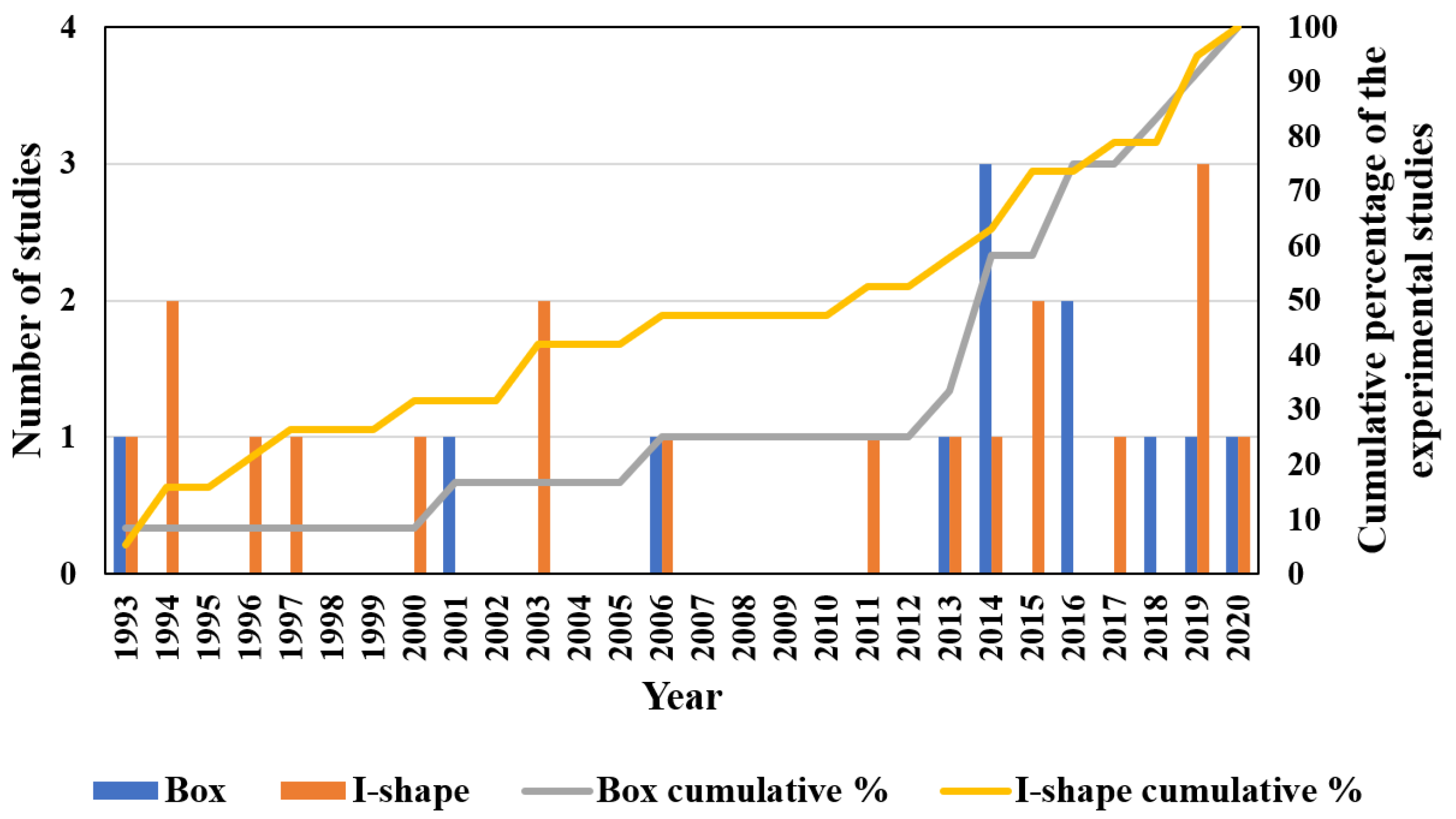
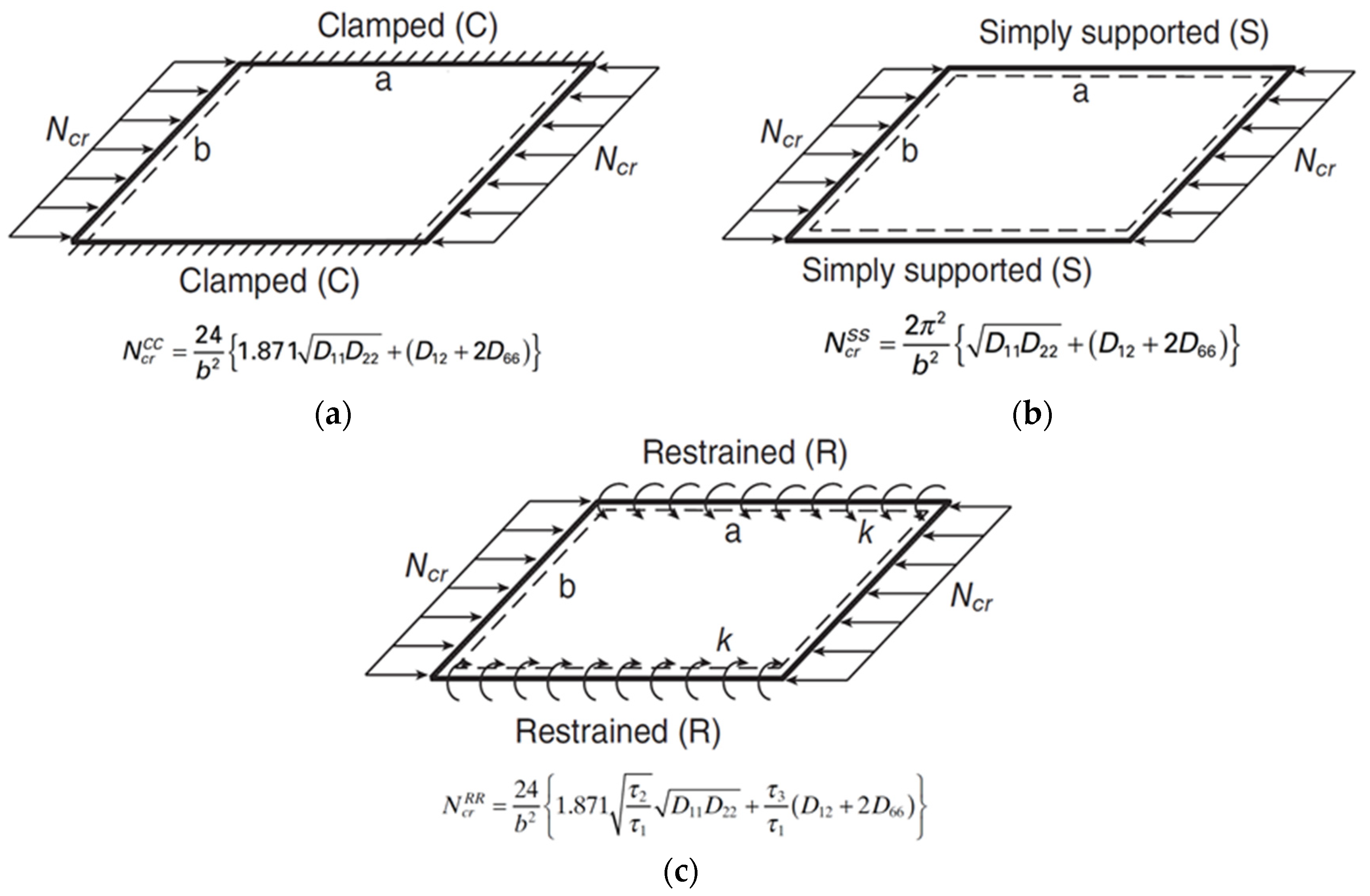



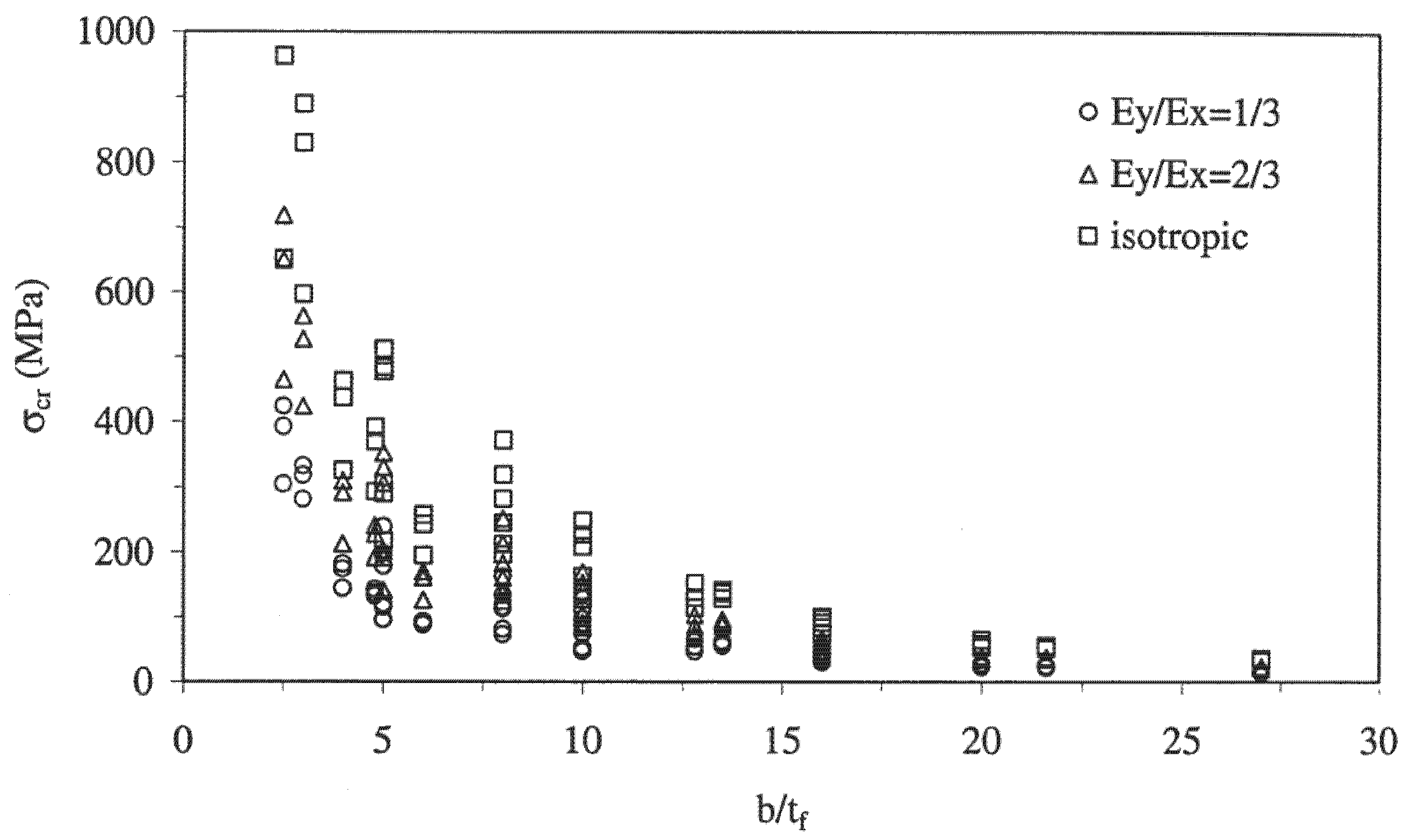


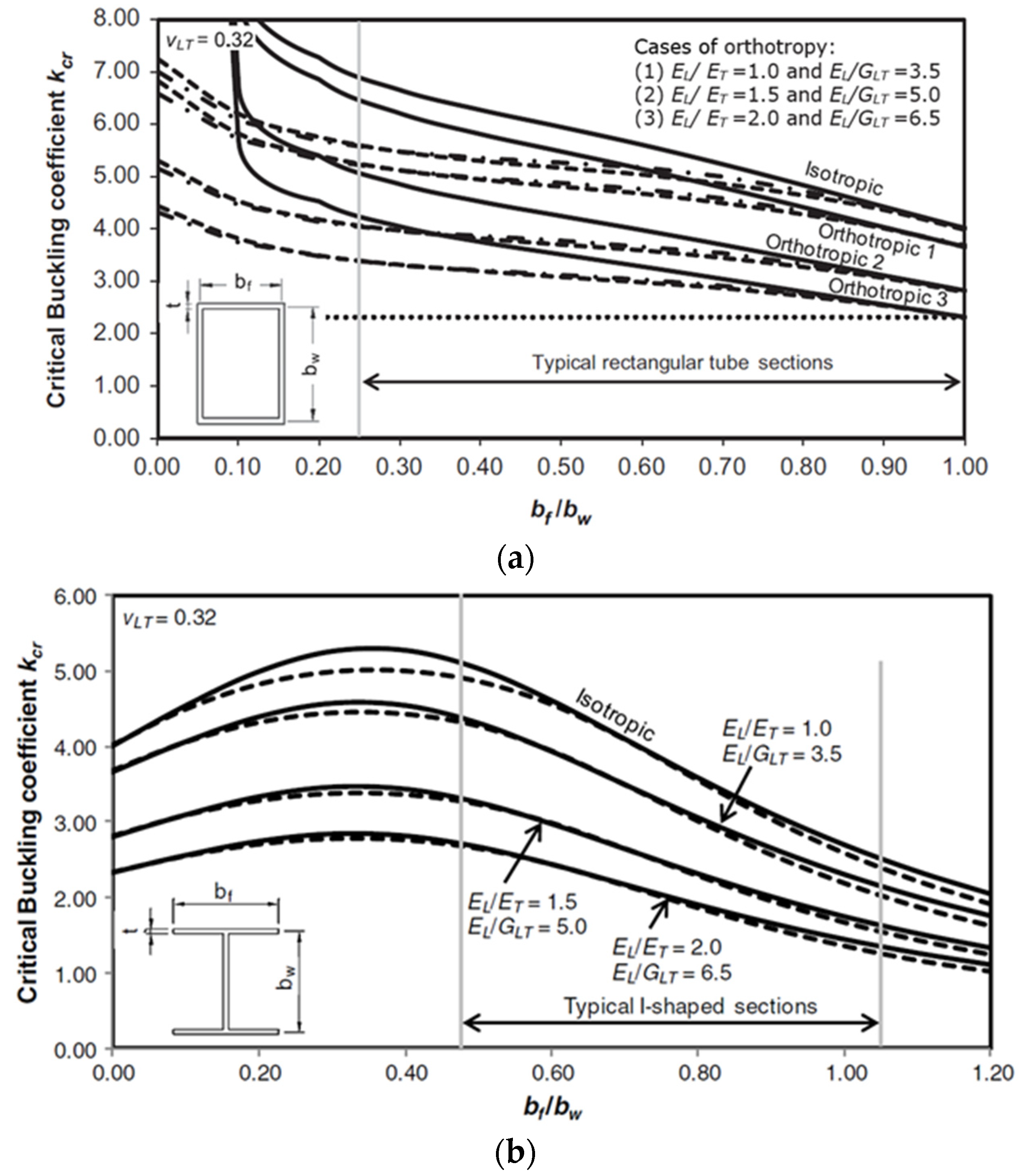
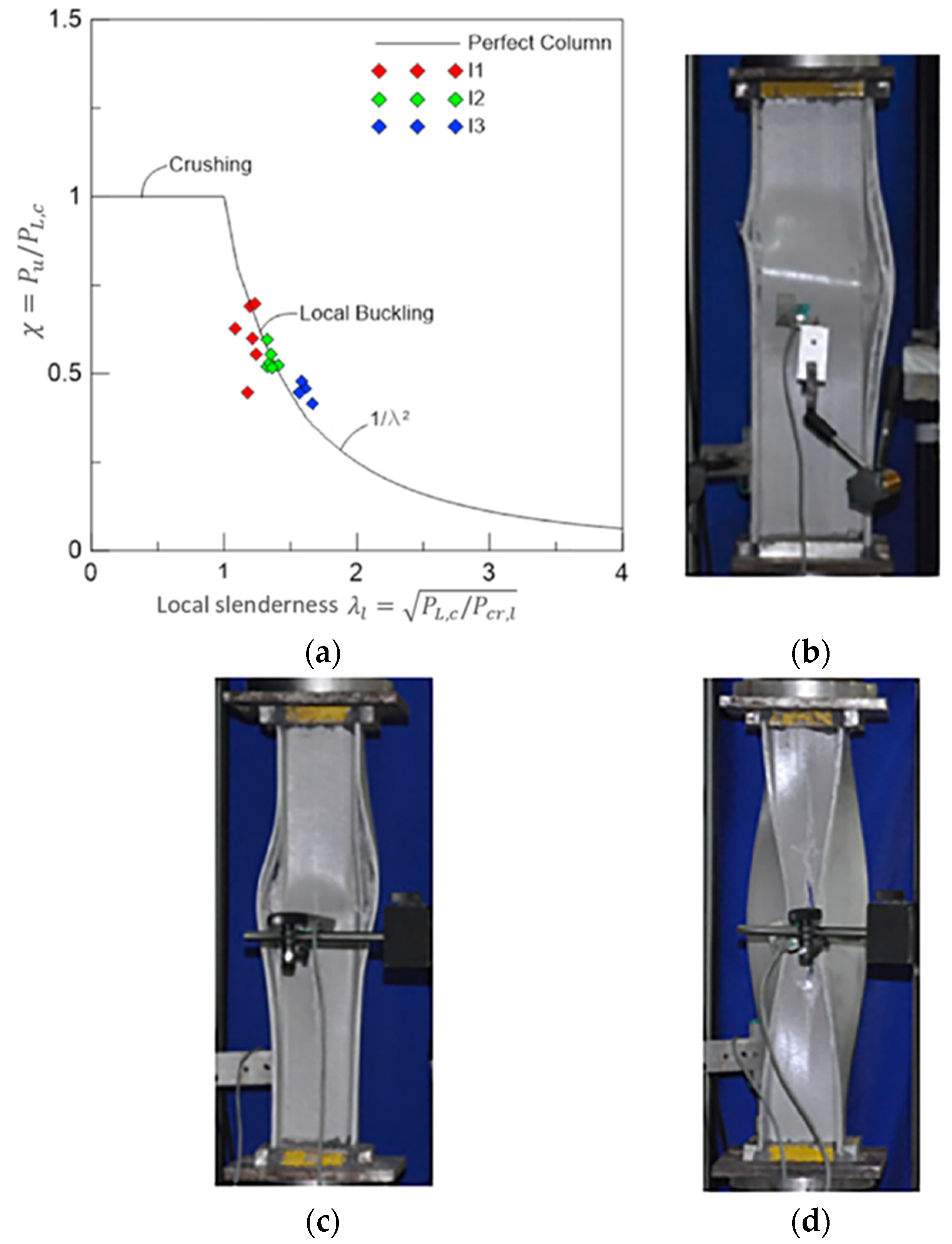
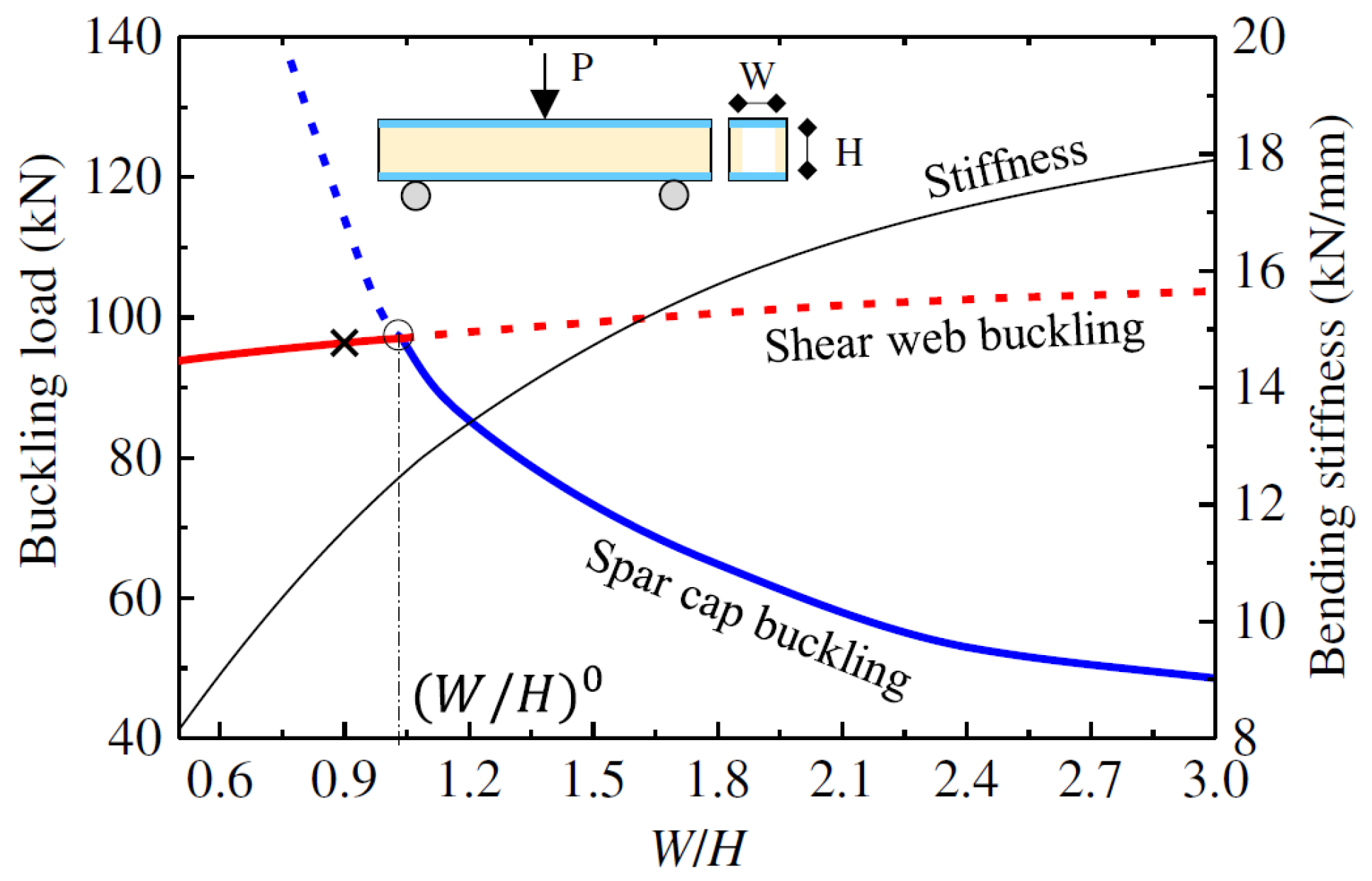
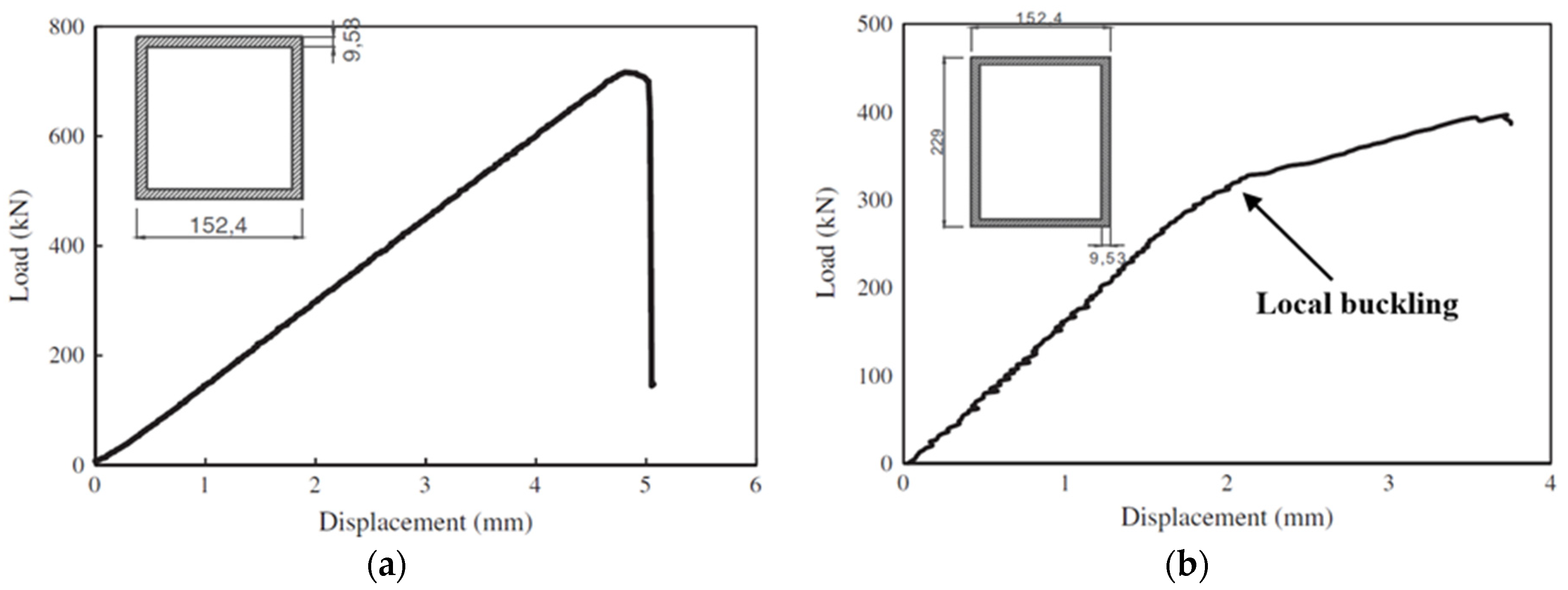
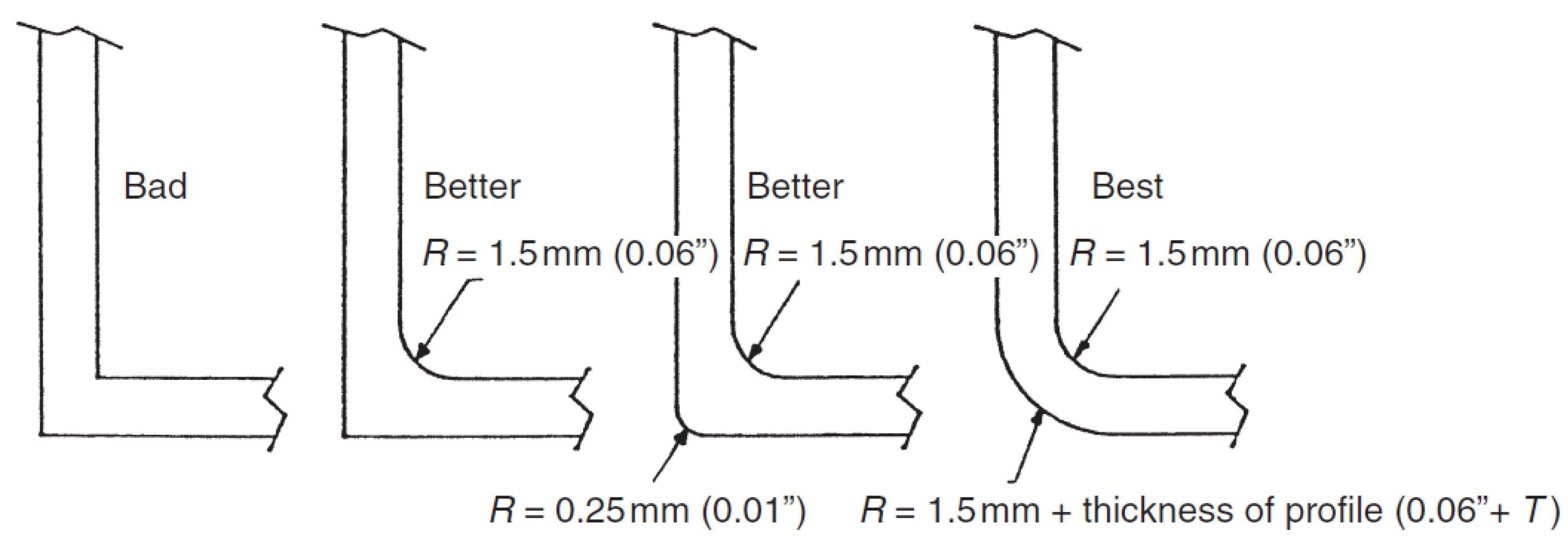
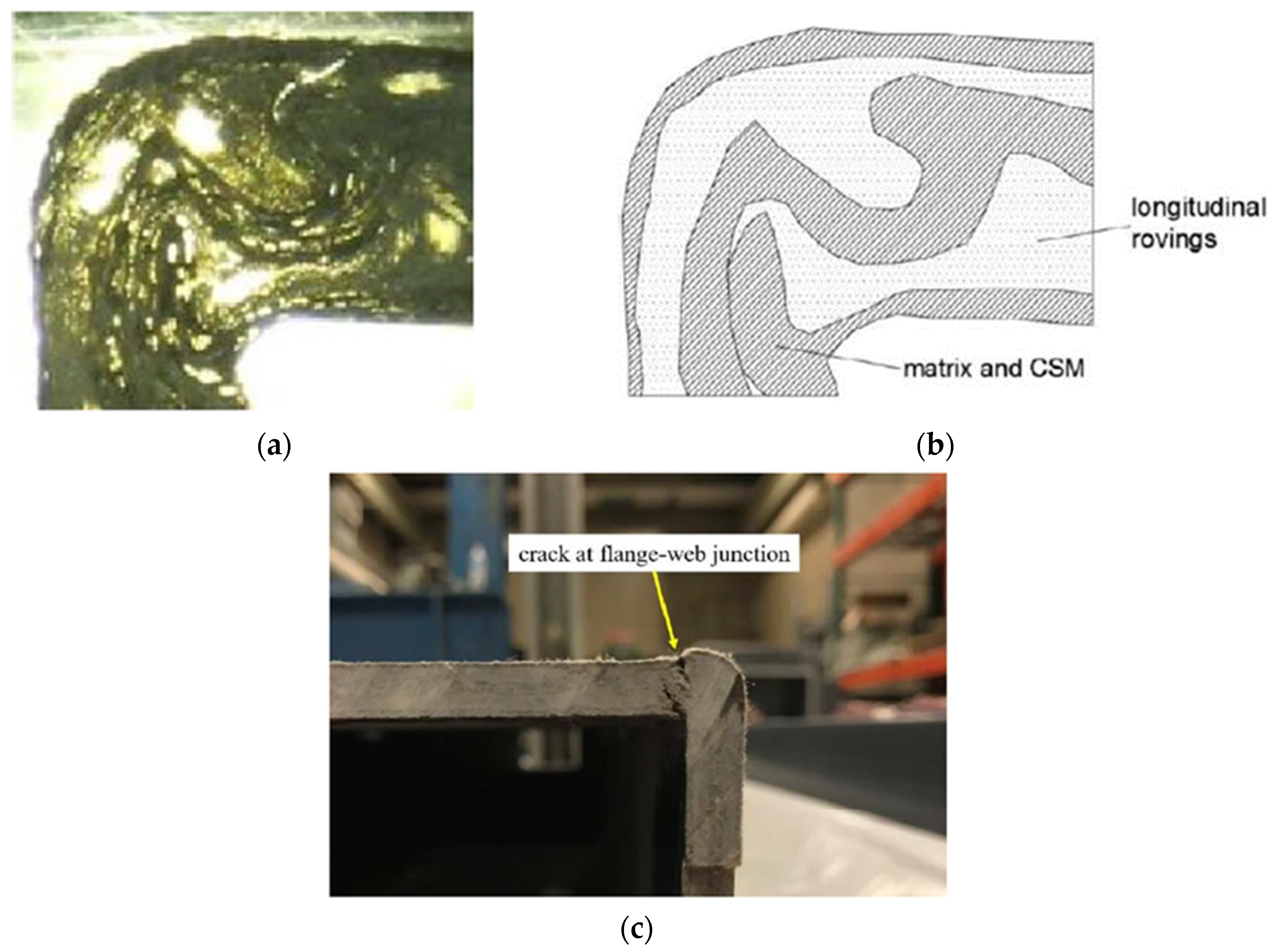
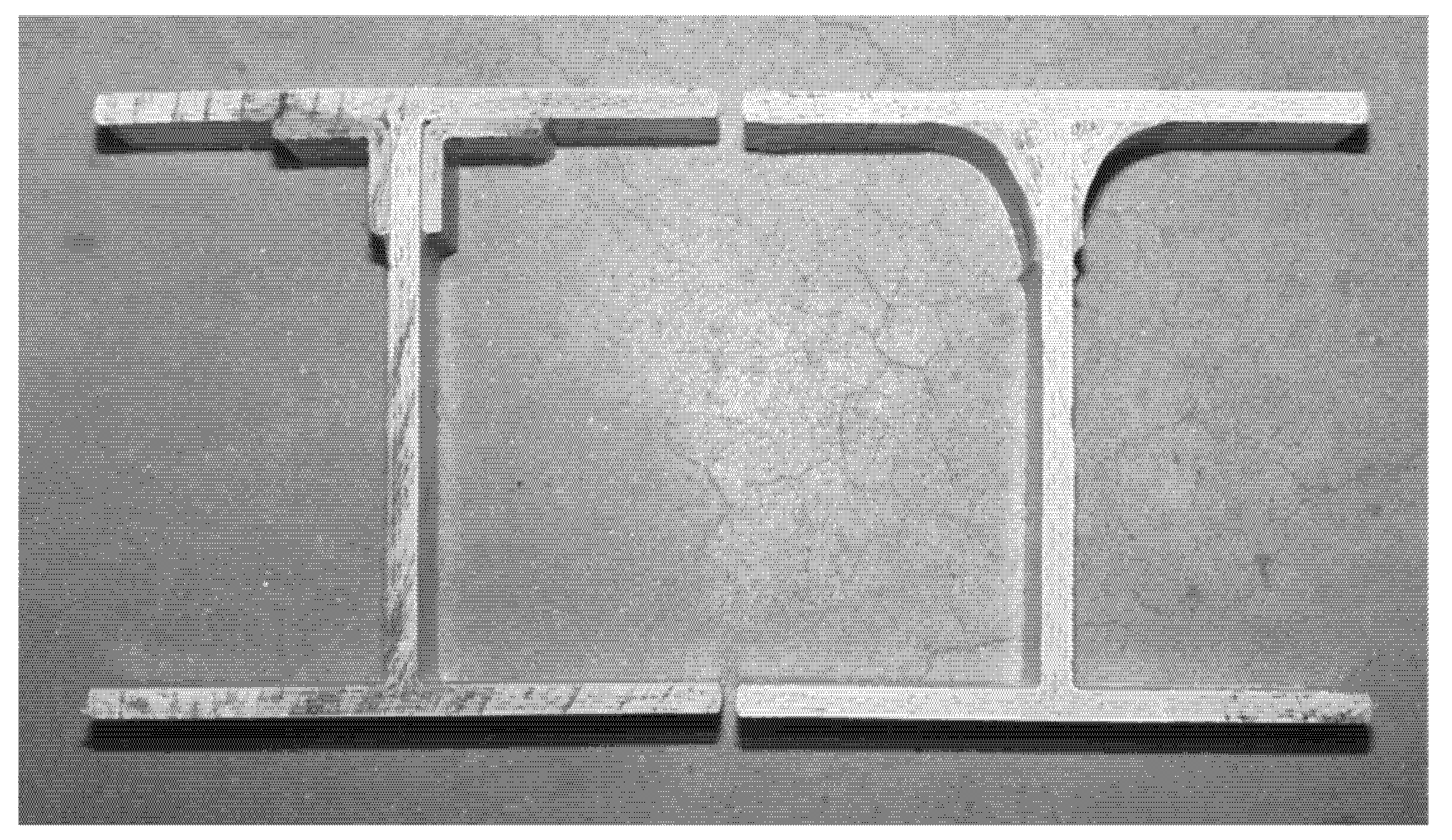

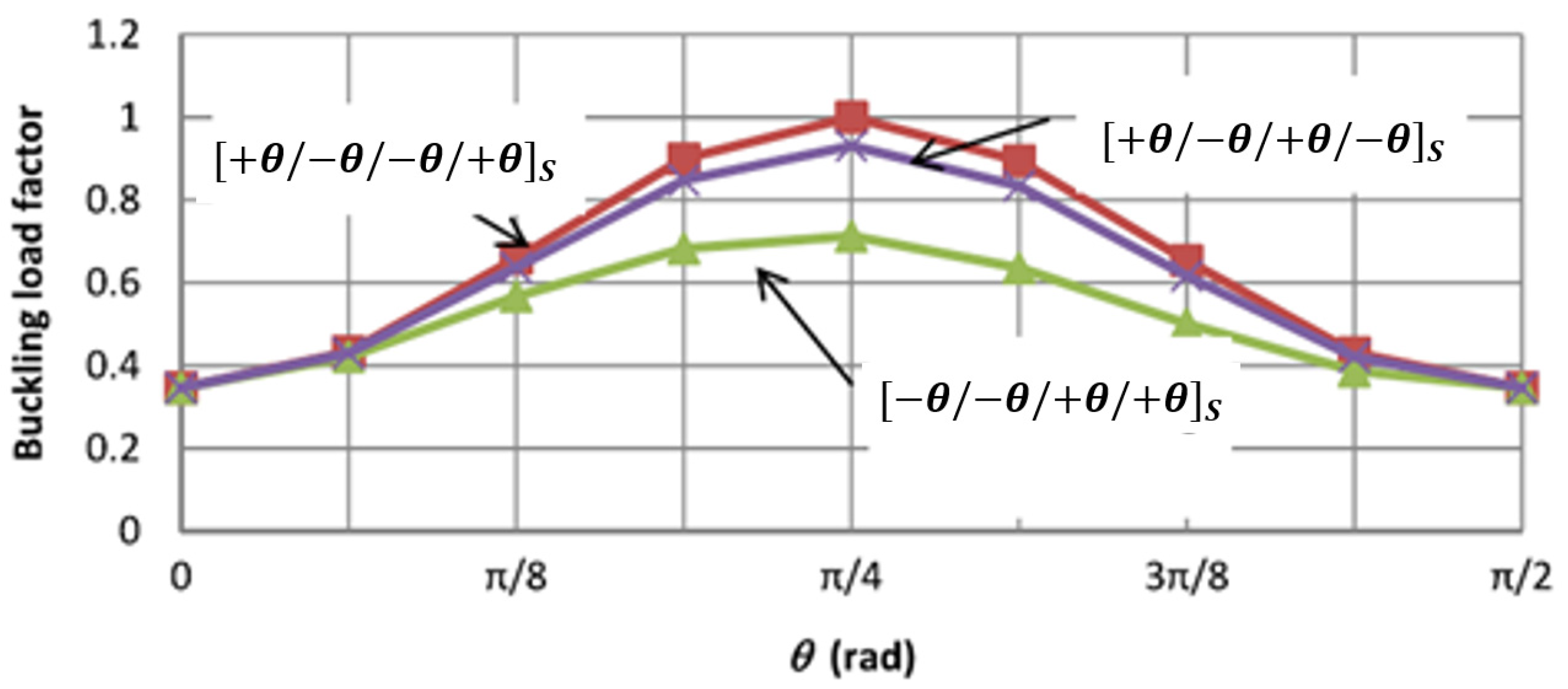
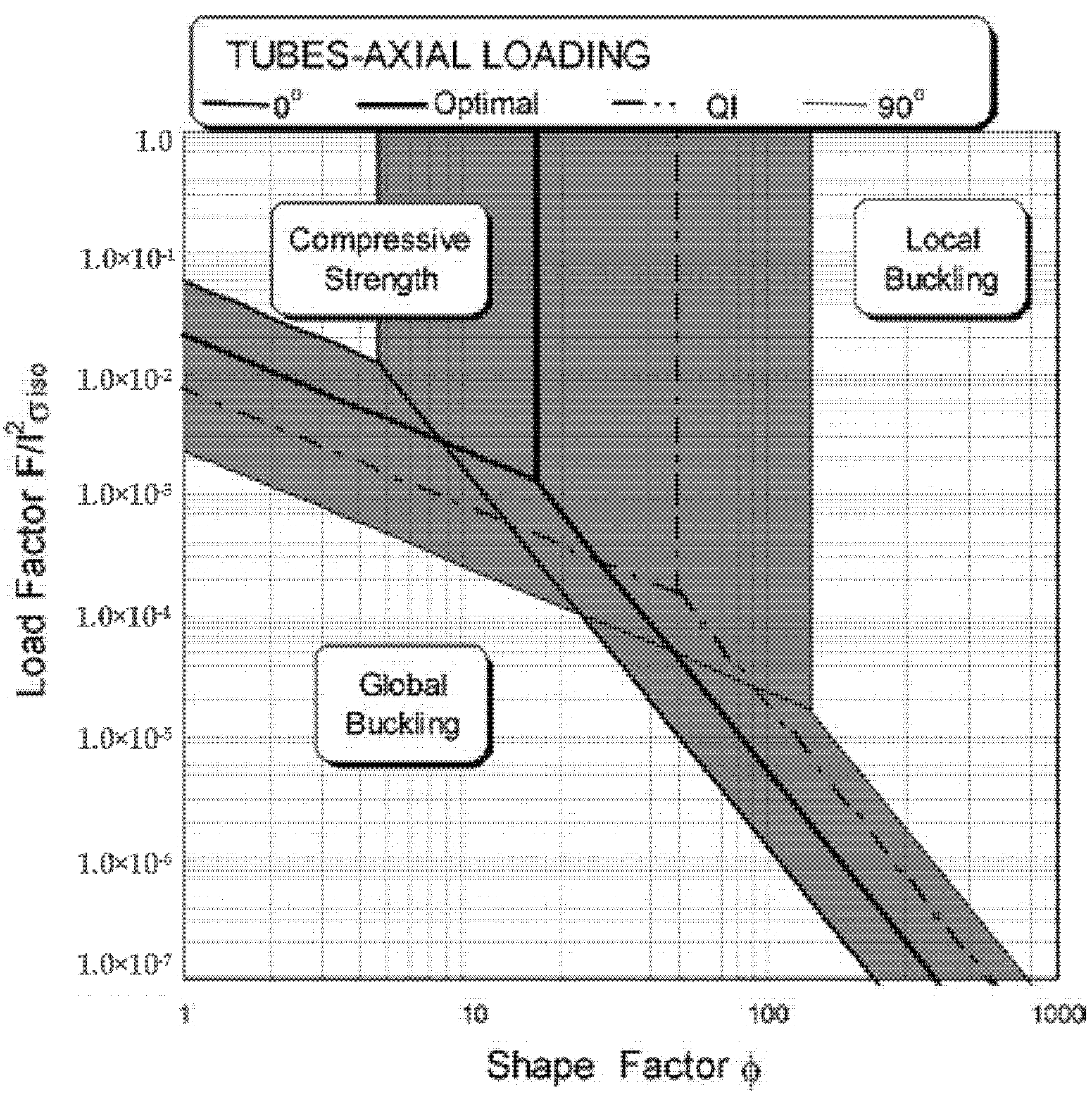
| Design Standard | Considered Geometry | Design Formula 1 |
|---|---|---|
| Pre-standard for load & resistance factor design (LRFD) of pultruded fibre-reinforced polymer (FRP) structures [177] | Hollow box | |
| I-shape | ||
| Prospect for new guidance in the design of FRP [178] | Hollow box | Where: |
| I-shape | Same as [180] | |
| Structural Design of Polymer Composites EUROCOMP Design Code and Handbook [179] | Orthotropic plate | Where: |
| Guide for the Design and Construction of Structures made of FRP Pultruded Elements [180] | I-shape | Where: |
| Profile Dimensions | Parameters | Level 1 | Level 2 | Level 3 |
|---|---|---|---|---|
| Section (mm): 100 × 100 | Wall thickness (mm) | 5.2 | 6.4 | 7.8 |
| Corner radius (mm): inner 4.8 and outer 10 | Winding angle (degrees) | 45 | 60 | 75 |
| Height (mm): 500 | Axial-to-wound fibre ratio (%) | 80/20 | 70/30 | 60/40 |
Publisher’s Note: MDPI stays neutral with regard to jurisdictional claims in published maps and institutional affiliations. |
© 2021 by the authors. Licensee MDPI, Basel, Switzerland. This article is an open access article distributed under the terms and conditions of the Creative Commons Attribution (CC BY) license (https://creativecommons.org/licenses/by/4.0/).
Share and Cite
Alhawamdeh, M.; Alajarmeh, O.; Aravinthan, T.; Shelley, T.; Schubel, P.; Mohammed, A.; Zeng, X. Review on Local Buckling of Hollow Box FRP Profiles in Civil Structural Applications. Polymers 2021, 13, 4159. https://doi.org/10.3390/polym13234159
Alhawamdeh M, Alajarmeh O, Aravinthan T, Shelley T, Schubel P, Mohammed A, Zeng X. Review on Local Buckling of Hollow Box FRP Profiles in Civil Structural Applications. Polymers. 2021; 13(23):4159. https://doi.org/10.3390/polym13234159
Chicago/Turabian StyleAlhawamdeh, Mohammad, Omar Alajarmeh, Thiru Aravinthan, Tristan Shelley, Peter Schubel, Ali Mohammed, and Xuesen Zeng. 2021. "Review on Local Buckling of Hollow Box FRP Profiles in Civil Structural Applications" Polymers 13, no. 23: 4159. https://doi.org/10.3390/polym13234159
APA StyleAlhawamdeh, M., Alajarmeh, O., Aravinthan, T., Shelley, T., Schubel, P., Mohammed, A., & Zeng, X. (2021). Review on Local Buckling of Hollow Box FRP Profiles in Civil Structural Applications. Polymers, 13(23), 4159. https://doi.org/10.3390/polym13234159







